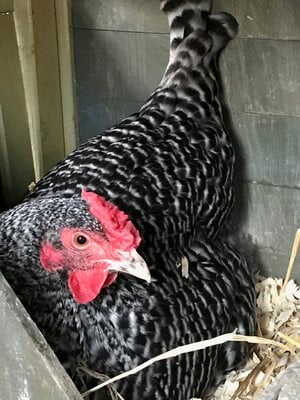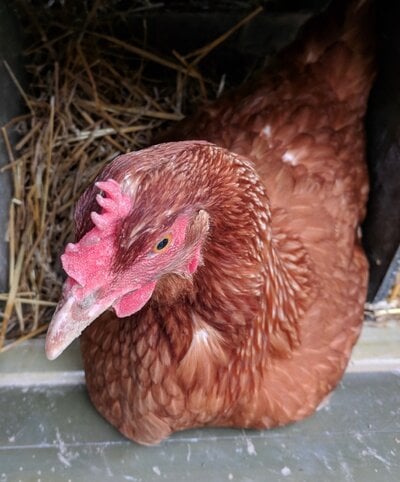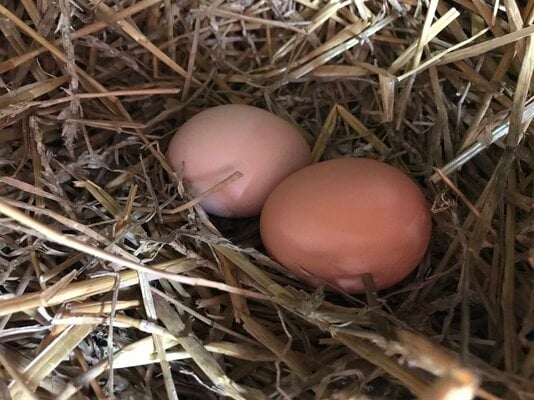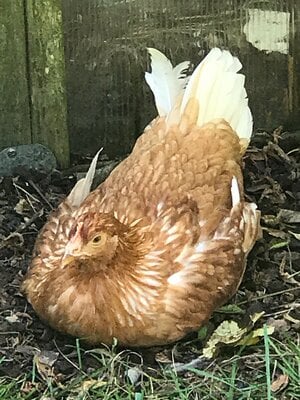Define Behavior
Here we will unravel the mysteries of egg-laying behavior. Jacob (2015) terms behavior as “the way in which an animal or person acts in response to a particular situation or stimulus”. Laying performance can be influenced by human interaction and is referred to as socialization, which can be good for the flock. Ideal times to visit are before laying begins in am and after laying is finished for the day. Interruptions at peak laying times may result in floor laying. By visiting the hen house, the chickens are exposed to low levels of stress, which the chickens can get acclimated to thereby improving socialization skills.Bacterial Risk
Most hens will lay their eggs in a nest but some however will be found in the coop, floor of run, or free-range areas. Floor eggs have an increased risk of bacteria due to soiling with manure, cracking, and timeliness of harvest. By increasing your knowledge of egg-laying behavior you will reduce the chances of laying outside the nesting box and therefore bacterial exposures.Ideal Nesting Box
Hens enjoy laying in enclosed dark nesting boxes frequently in the back of the coop and many will join once eggs are found in the nest placed there by others. The nesting box should be tall enough for each hen to enter and exit including turning without difficulty. Leaving the tops of the boxes open is optimal for acceptable height plus no chance of the top being used for roosting and subsequently a manure collection site. You may have a single nesting box area or multi-bird boxes. Single bird nests may be ideal for small flock owners while commercial poultry owners might enjoy the multi-bird boxes for larger flocks (Webster, 2007). Avoid having other areas that are dark enclosed spaces in the coop so hens do not use them as nesting boxes. The ideal size of the nesting box is 12 x14 inches to include the height of the tallest standard breeds. My nesting boxes are open on top so no headspace infringement and no place to use as a roost.Litter of Choice
The litter in a nesting box most often is loose pine shavings or straw as easiest to clean and most resembles a nest a bird would choose for their eggs. Hens enjoy nest-building behavior prior to laying involving arranging or molding the loose bedding with their bodies or feet. If no litter is found in the nest box, you may see more floor laying. Do not use loose litter in other areas such as run of the coop as this may encourage hens not to use the nesting boxes. Replace litter frequently to keep it clean and dry to avoid pests, parasites, or dirty eggs.Search and Site Selection for Nest
Young pullets should be encouraged to use and scout out the nesting boxes prior to laying as it takes several weeks to recognize appropriate nest sites. If pullets start laying before proper introduction to nest boxes, you may have a difficult time getting them to use the nest boxes. If nesting boxes are above floor level it may take some time for the pullets to get used to getting up on perches or roosts to access the nesting boxes. Remember practice makes perfect! Additionally, remember that heavier breeds may not be able to get up as high and may require nesting boxes lower down to access. If hens are not comfortable accessing the nest box again this may lead to floor laying. Boxes no higher than 24 inches off the ground with perch or ladder access protects from predators while providing a safe easily accessible place to lay eggs.Hens have a strong internal instinct to exhibit pre-laying behavior before oviposition, which comprises the search phase, nest site selection, and formation of a hollow nest (Webster, 2007). Different breeds may take more time in the different phases of nest selection and preparation, for example, a White Leghorn may have a prolonged time to search and select a nest site by trying different potential sites first before selecting a final nest for laying (Jacob, 2015; Webster, 2007). Medium-weight brown egg layers are known for spending more time on nest building and hollowing out the nest by sitting in the nest and gathering the nest around them. (Jacob, 2015; Webster, 2007).
Pre-laying Behavior
Pre-laying behavior occurs in response to hormone stimulation triggered by last ovulation and occurs during a certain period on any given day. This occurs prior to the yolk presence in the shell gland. It occurs most often 1-2 hours prior to laying the egg and peaks with hens sitting in a nest to lay an egg. If egg laying is delayed for whatever reason then the time for pre-laying behavior will pass and the hen will find no need to seek a nest. In this case, again the hen may lay her egg in an alternative location due to a disturbance, stress, or lack of knowledge regarding imminent egg passage. Too much competition for the nesting box may force a hen to find an alternative location for laying as well. (Jacob, 2015; Webster, 2007).Nesting Box Ratio and Disturbances
Make sure you have plenty of nesting boxes for older hens and young pullets alike. A good ratio is one nesting box for every 4-5 hens. I have 3 nesting boxes and all four of my hens will use the nesting box that is the furthest and darkest box in the back of the coop. Rarely, I will have a floor egg or an egg in another nesting box. The slightest disturbance will interrupt the hen resulting in floor laying because the hen will not return to the box. This holds true. I have walked out to check the nesting boxes, opened the egg door, and found a hen in the box laying. She stepped out and the egg was laid on the floor of the coop even though I quickly closed the door and encouraged the hen to return to the nesting box. My next eggs are always in the box if not interrupted. The nesting box has to be a protected peaceful uninterrupted place for the hens to use. Your hens will eventually get used to using alternative boxes usually the next one over from the back when the ideal nesting box is in use, as they get older and more experienced. So check all boxes as occasionally you may find they will use another box (Webster, 2007).Nesting Box versus Litter Location
Hens can differ in choices for a nesting location. When a group of hens was given the choice of a nesting box versus a litter tray, the majority of hens preferred the nesting box. Those hens that selected the litter tray spent more time exploring it prior to laying but also had a shorter final trip when the egg was finally laid (Jacob, 2015; Zupan et al., 2008). In a study of 24 hens offered a nesting box or litter tray 17 hens chose the nesting box while the remaining 7 hens laid in the litter tray of the first 20 eggs laid (Zupan et al., 2008). There were no differences in the number of entries to the chosen nest location. This indicates that there are layers of two types nest layers and litter layers with different types of pre-laying behavior.Pre-laying Signs
So what does pre-laying behavior look like? Hens may show restlessness while beginning to look for a nest poking heads into the nest boxes available. Between nest explorations, hens may resume other behaviors such as eating, preening, sleeping, etc. Eventually, the hen will put more and more of her body in the nesting box until she finally settles in the box to lay her egg. Hens may settle in the nest they lay, cackle, and then leave the nest. (Jacob, 2015).As hens become more experienced, the level of restlessness reduces. In the hour prior to oviposition foraging and resting increase while exploring, nest seeking, and nest site visits decrease. (Zupan et al., 2008). Comfort and confidence increase with experience.
Training to the Box
Does this mean you cannot train your hens to lay in nesting boxes if found to be a litter layer or floor layer? No! But these hens may always have this tendency so it is important to encourage proper behaviors early on. Of four hens, I had two nesting box layers and two floor layers initially. My Golden Buffs laid well in the nesting boxes and I had to train my Barred Rock and Speckled Sussex to lay in the nesting box as initially, they enjoyed floor laying in the back of the coop. I blocked the portion they chose to lay in for several weeks, which stimulated them as young pullets to lay in the nesting box. I now have four hens that lay in the same nesting box. Seeing other hens lay in the box also encouraged them to use the nesting boxes. The real eggs of others are always an attraction. We all want what someone else has right! To get the first layers started you can use false ceramic eggs in the nesting box; this worked well for me.Hope you enjoyed this article illuminating nesting behaviors so you know what to expect and encourage with your flock.
Good Luck with your flock!

Remy (Barred Rock) in lay.
References
Good Luck with your flock!

Remy (Barred Rock) in lay.
References
Jacob, J. (2015). Normal behaviors of chickens in small and backyard poultry flocks. The University of Kentucky.
Webster, B. (2007). Backyard flock tip: Egg-laying behavior. Poultry, pp1-4. https://thepoultrysite.com/articles/backyard-flock-tip-egg-laying-behavior
Zupan, M., Kruschwitz, A., Buchwalder, T., Huber-Eicher, B., and Stuhec§, I. (2008). Environment, well-being, and behavior comparison of the pre-laying behavior of nest layers and litter layers. Poultry Science, 87, 399-404.
Video displaying egg nesting behavior prior to lay with one already in the box. Raven and Remy.




